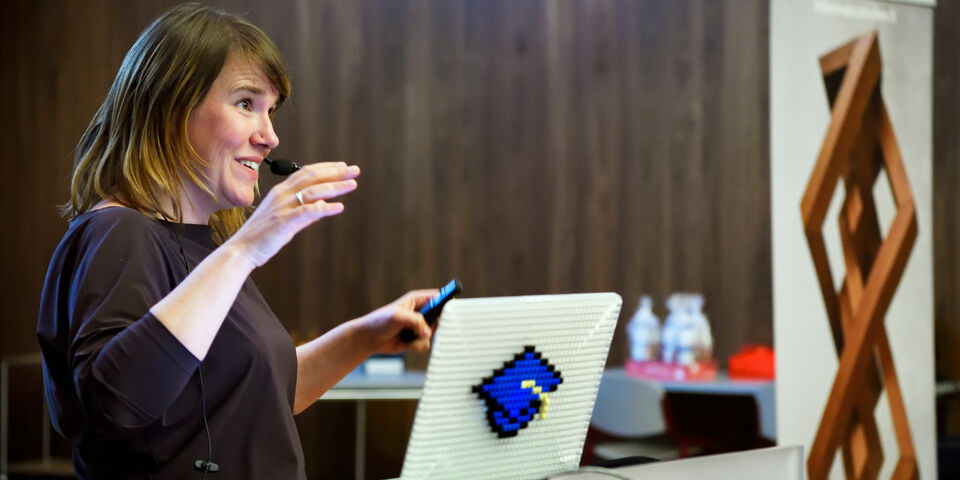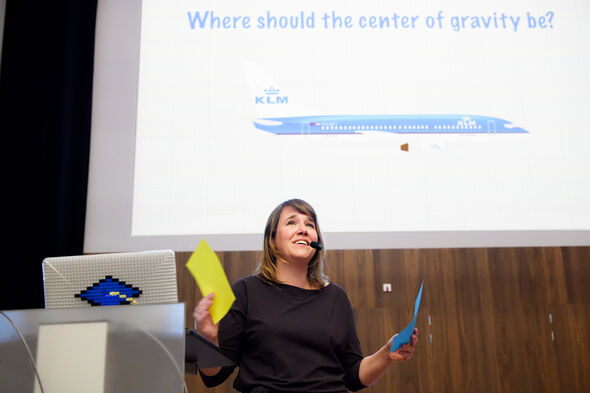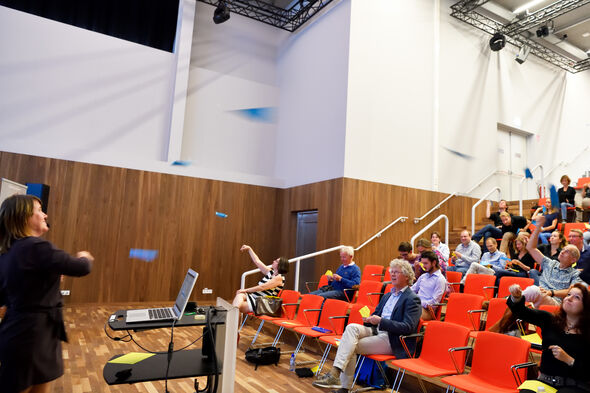This is the way to celebrate math
On the initiative of the Dutch branch of European Women in Mathematics (EWM-NL) mathematics was celebrated in TU/e building Luna on Monday afternoon. Four mathematicians were given an open podium. The audience got to hear stories that made it inconceivable for any listener why not everybody loves math.
Rector Magnificus of TU/e Frank Baaijens (who is not a mathematician but a mechanical engineer) narrates by way of welcome what mathematics meant for him as a researcher of tissue engineering in heart valves. “Seventeen years ago we were still wrestling with the problem that swellings arose at the edges of our heart valves. We processed the action of the cells in mathematical models so that it became possible to predict the behavior of cells. What we could not manage by using intuition, we succeeded in achieving by means of math. This led to a breakthrough in an area where one might not expect it.” As far as he is concerned, it is a good reason to celebrate mathematics.
You do not need to tell that to the people in the audience. Nor would you say to professor Nelly Litvak (at TU/e and at Twente University) that mathematics is not ‘your thing’. The professor of Algorithms for Complex Networks aims to tell the public at large that mathematics really is their thing. Last summer together with Alla Kechejan she started the lemma `Mathematics - Great and Terrible’ on Facebook about math for non-mathematicians.
Orange rind
This page, she says, arouses loads of emotional reactions when, for example, it is explained by means of photos of an orange rind that the surface of a ball is four times as big as the surface of a circle. They show that math is not dull by any means. Buffs reacted: 'Mathematics on pies - for housewives'. Non-mathematicians reacted: 'It was fantastic. If at school they explained mathematics like this, I would now be building spacecrafts'.
Litvak explains how she came to popularize math. Her latest book ‘Who Needs Mathematics?’ is the result of a reaction from a customs officer when she told her what she wanted to do on the other side of the border. Indeed, the officer said: “And, somebody still needs mathematics?”. Litvak found it paradoxical, “for the customs service uses computers with intricate graphs and it scans fingerprints. This woman clearly did not have a clue as to how strongly math is connected to the digital world.”
The professor has no ambition to change the way math is taught. “Still, scientists should be aware that mathematics should be inclusive, so available to everybody. Math is not special and we should be able to explain it the way doctors talk to their patients. Without medical jargon, but they should not settle for: 'The human body is so complicated, we are not going to talk about that'.”
Popularization
Ionica Smeets, a professor at Leiden University, thinks that the best way to talk about mathematical problems is ‘storytelling’. “Good evidence also often sounds like a good story. Whatever you do, do not use the age-old order of introduction, goals, experiment, results, conclusion. Begin with the action, for that’s how Netflix operates as well.”
Tips from Ionica Smeets are, in summary: do not only give the numbers, bring along objects that fit in with your story, make contact with the audience “and steal tricks from Dan Brown. Do not forget what you want to say exactly, though”. And when Smeets wants to explain the best place for the center of gravity of an airplane, she makes her listeners fold a paper airplane, asks them to attach a paperclip as the center of gravity in two different ways (on yellow paper it should be attached to the front, on blue paper to the tail) and carries out an experiment.
The tip to bring along materials had long been taken on board by Assistant Professor Tom Verhoeff. Beside a table filled with mathematical art objects he talks about the connection between art and problem solving.
On floor 1 of MetaForum a portrait gallery will be set up next month of thirteen European women who are important in mathematics: a beautiful photo, their favorite formulas and some statements that spark the passion for mathematics. There is no Dutch woman among them and Maria Vlasiou from EWM-NL knows why. “The number of lady professors of math is disappointingly low in the Netherlands. There are fewer than ten. Moreover, the photo series was taken at a conference attended by very few Dutch guests.”




Discussion